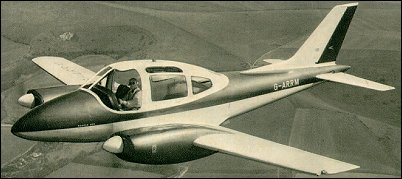|
| Twin-engined light transport aircraft with accommodation for five to eight persons. The first prototype flew on 15 August 1961, powered by a Continental 194kW IO-470-A engine, and was smaller than subsequent B.206. The second prototype had increased dimensions and a 231kW Rolls-Royce/Continental GIO-470-A engine. The initial commercial version was the B.206 Series I or B.206C. The B.206R was the military production version, ordered for communications and ferrying duties with the RAF under the name Basset CC.l. The B.206-S was a development of the Series I with supercharged engines and other refinements. Deliveries included two ambulance models for the Royal Flying Doctor Service of New South Wales, Australia. By the close of 1969 40 B.206 Series I and II aircraft, 20 Bassets and two B.206Z pre-production types for the Ministry of Technology had been delivered.
| CREW | 1 |
| PASSENGERS | 4-7 |
| ENGINE | 2 x RR/Cont. GIO-470, 230kW |
| WEIGHTS |
| Take-off weight | 3223 kg | 7106 lb |
| Empty weight | 1978 kg | 4361 lb |
| DIMENSIONS |
| Wingspan | 13.9 m | 46 ft 7 in |
| Length | 10.3 m | 34 ft 10 in |
| Height | 3.4 m | 11 ft 2 in |
| Wing area | 19.9 m2 | 214.20 sq ft |
| PERFORMANCE |
| Max. speed | 352 km/h | 219 mph |
| Cruise speed | 348 km/h | 216 mph |
| Ceiling | 6210 m | 20350 ft |
| Range | 1500 km | 932 miles |
| Range w/max.fuel | 3000 km | 1864 miles |
| Range w/max payload | 1850 km | 1150 miles |
| bvcxzmlppd, e-mail, 15.03.2021 12:27 Muchas gracias. ?Como puedo iniciar sesion? reply | | Barry, 01.03.2012 11:20 Beagle saw the B206 as a replacement for the Avro Anson. Expecting an order of in excess of 100 aircraft from the RAF they were dismayed that the requirement was for only 40 aeroplanes, which eventualy became an order for just 20 airframes.To meet the specification for the military B206, known to the RAF as the Bassett CC1, Beagle employed a drawing office staff of 100. This was the entire office, which when you compare it with Cessna who at the time had adrwing office of some 70 people puts into pespective the problems that Beagle were suffering. With design and test flying at Shoreham and manufacture at Rearsby there was no way that this company could survive.
Trying to market reheated Auster product and poorly deigned aircraft such as the underpowered Airedale meant that there was never any real hope. The one truly original aircraft was the Miles designed M218 which was to be built using plastics, but because the materials used were unusual the investment needed to meet official standards was not available and so the aeroplane was built using metal with the obvious result that "what you got was not what you wanted". reply | | Howard Funnell, e-mail, 21.02.2012 17:48 Was looking for information on the Miles M218 and google directed me here. I have to disagree with David Harris, that is NOT a drawing of the M218. It appears to be a representation of the Beagle B242 which was developed from the M218 but managed to ruin the looks! Much of the plastic was removed and replaced with metal to produce this design. reply | | Paulo Franco, e-mail, 30.11.2010 15:43 The engine in Series III was a GTISO-520 developing 340 hp.
I have almost 3000 h in type! It was a nice, pleasent airplane, and if had some modification could still im production today. reply | |
| | David Harris, e-mail, 23.02.2010 01:08 The 3 view drawing is not of a B206. The drawing is of the Beagle M-218 of which only a prototype was built. It first flew out of Shoreham Airport on 19th August 1962 flown by Gerorge H Miles. The late Grahame Gates was the chief designer. It was ahead of it's time in that over 60% of it's surface area was of glass fiber. reply | | John Appleby, e-mail, 19.11.2008 13:46 I was employed as an aircraft mechanic on these aircraft in 1966-67 at Northern Communication Squadron, RAF Topcliffe. When this aircraft was fully loaded for it's wartime role (V-bomber aircrew dispersal) it had vrtually nil range and the props had to be modified as they struck the ground! I flew in them occasionally and they were a pleasant aircraft to fly in with good all round visibility.
JA reply |
|
Do you have any comments?
|
| 
COMPANY
PROFILE
All the World's Rotorcraft
|







